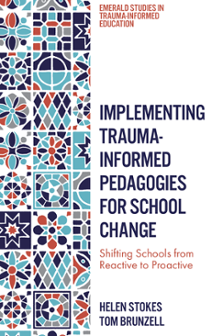
Index
Helen Stokes
(University of Melbourne, Australia)
Tom Brunzell
(University of Melbourne and Berry Street Victoria, Australia)
ISBN: 978-1-83797-001-8, eISBN: 978-1-83797-000-1
Publication date: 19 February 2024
This content is currently only available as a PDF
Citation
Stokes, H. and Brunzell, T. (2024), "Index", Implementing Trauma-informed Pedagogies for School Change: Shifting Schools from Reactive to Proactive (Emerald Studies in Trauma-Informed Education), Emerald Publishing Limited, Leeds, pp. 87-89. https://doi.org/10.1108/978-1-83797-000-120241007
Publisher
:Emerald Publishing Limited
Copyright © 2024 Helen Stokes and Tom Brunzell
INDEX
Adverse childhood experiences (ACE)
, 4
Appreciative inquiry participatory action research (AIPAR)
, 24, 29, 46, 59
cycles
, 60, 67
with TIPE
, 24–26
Appreciative inquiry process strategies
, 25
Attitude to school surveys (AtoSS)
, 26, 34
Auditing and reviewing TIPE strategies in classrooms
, 64–65
Bottom-up capacities
, 9–11
Brain break
, 19–20
Check-in strategies
, 55
Childhood trauma studies
, 4
Classrooms, auditing and reviewing TIPE Strategies in
, 64–65
Co-regulation
, 18
Collective teacher efficacy (CTE)
, 40, 55
Community-wide approach
auditing and reviewing TIPE strategies in classrooms
, 64–65
developing confidence and competence to deliver consistency of practice
, 63
future directions for TIPE
, 66–71
importance of context
, 60–62
structured coaching
, 65–66
towards trauma-informed education systems
, 71–73
Competence to deliver consistency of practice
, 63–67
Confidence to deliver consistency of practice
, 63–67
COVID-19
, 2, 29
Culturally responsive pedagogies
, 72–73
De-escalation
, 19
Design process
, 15
Dinosaur brain
, 50
Education systems
, 72
Einstein brain
, 50
Fidget tools
, 11, 19
Garron Secondary College
, 27, 31, 34, 39–40, 42, 45–47, 55, 59–64, 66, 68, 71, 76
challenges and future opportunities
, 41–43
context
, 27–29
implementation of TIPE at
, 31–35
initiating professional learning in TIPE
, 30–31
professional learning for whole school
, 29–30
reframing TIPE within school’s instructional model
, 35–36
shifting school culture to non-punitive approach
, 31–35
impact of TIPE
, 39–41
Individualised teacher coaching session
, 52
Instructional approach
, 37, 39
Leader
, 54
Learning
, 17
Mindful practices
, 20
Missouri Model
, 6, 10
National Child Traumatic Stress Network, The
, 13
Non-clinical professionals
, 4
Non-punitive approach, shifting school culture to
, 31–35
Non-therapeutically trained professionals
, 3
Parent volunteers
, 69
Pedagogical progress
, 68
Positive education
, 23
Positive primer
, 37
Proactive behavioural management, TIPE strategies for
, 53–56
Proactive support
, 54
Professional learning
initiating professional learning in TIPE
, 30–31
for school
, 29–30
with TIPE
, 24–26
undertaking professional learning in TIPE
, 46–47
Professional learning teams (PLTs)
, 63
Psycho-education
, 50
Psychological resources for wellbeing
, 23–24
Qualitative methods
, 9
Ready to Learn Plans
, 32–33, 55
Ready to Learn Scale
, 55
Regulatory abilities, TIPE
, 18–21
Relational abilities, TIPE
, 21–23
Relational strategies
, 31
Safety
, 10
Safety Plan
, 20
Schools
culture to non-punitive approach
, 31–35
reframing TIPE within school’s instructional model
, 35–36
school-based mental health professionals
, 2
transitioning students throughout
, 51–53
trauma-informed education strategies for
, 15
Secure-base strategies
, 21
Self-regulation strategies
, 19
Sensory strategies
, 11, 19
Social emotional learning (SEL)
, 1, 7, 12
Strength spotting
, 23
Structured coaching
, 65–66
Students
, 5, 28, 40, 55
transitioning students throughout school
, 51–53
Teachers
, 3–4, 16, 18, 28, 38, 49, 54, 75
own capabilities
, 2–4
Top-down capacities
, 9, 11–13, 17
Trauma
, 3
Trauma-aware
, 6
Trauma-informed classrooms
, 11
Trauma-informed education
, 16–17, 23, 75, 76
approach
, 39
bottom-up capacities
, 10–11
building teachers’ own capabilities
, 2–4
foundations of
, 4–6
implementation layers of trauma-informed education intervention
, 7–8
literature
, 12
need for
, 1–2
ongoing iteration and definition of
, 6–7
prevalent themes of trauma-informed education
, 9
strategies for schools
, 15
systems
, 71–73
top-down capacities
, 11–13
Trauma-informed instructional approach
, 38
Trauma-Informed Positive Education (TIPE)
, 15–16, 18–19, 59, 75–76
impact of
, 39–41
approach
, 71
auditing and reviewing
, 64–65
Coaching Rubric
, 65, 67
developmental domains of
, 15
future directions for
, 66–71
hook
, 36
implementation of TIPE at Wiyal Primary School
, 47
increasing psychological resources for wellbeing
, 23–24
increasing regulatory abilities
, 18–21
increasing relational abilities
, 21–23
initiating professional learning in
, 30–31
instructional model
, 35, 39, 64, 67
learn, practise, and apply
, 37–38
lesson
, 48–51
proactive behavioural management
, 53–56
professional learning
, 47
professional learning and appreciative inquiry participatory action research with TIPE
, 24–26
reflection
, 38–39
strategies
, 32, 37, 54, 70
team
, 28
transitioning students throughout school
, 51–53
trauma-informed education strategies for schools
, 15
undertaking professional learning in
, 46–47
Trauma-informed schools
, 12
Trauma-responsive
, 6
Trauma-sensitive
, 6
University ethical process
, 26
Wellbeing, increasing psychological resources for
, 23–24
Whole school, professional learning for
, 29–30
Wiyal Primary School
, 45, 53–54, 56, 59, 61–69, 71
challenges and future opportunities
, 56–57
context
, 45–46
implementation of TIPE at
, 47–56
undertaking professional learning in TIPE
, 46–47